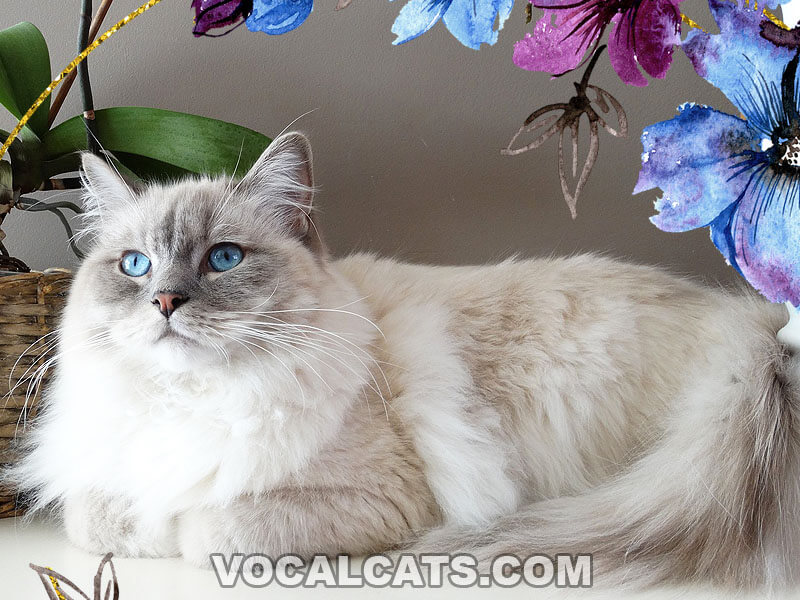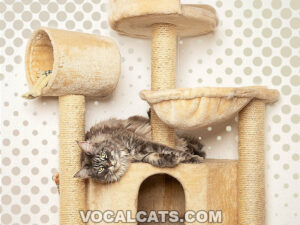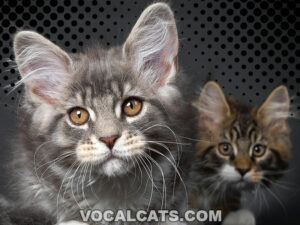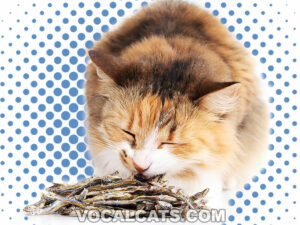The Blue Ragdoll is one of the recognized Ragdoll colors by major cat associations. Its light-colored body combined with the slate gray color points is what makes this feline so popular.
Blue Ragdolls, also known as Grey Ragdoll Cat, come in different color patterns, like the Blue Point Ragdoll or the Blue Mitted Ragdoll. In this comprehensive guide, we will dive deeper into their many color variations, as well as, ways to maintain this cat breed and how to search for the right breeder if you are ever up to buy or adopt one.
Contents
- Blue Ragdoll Cat: Breed overview
- What is a Blue Ragdoll Cat?
- Are Blue Ragdolls rare?
- Is Blue a recognized Ragdoll Cat color?
- Lilac vs Blue Ragdoll
- Blue Ragdoll physical appearance
- What color are Blue Ragdolls’ eyes?
- Do all Ragdoll Cats have Blue eyes?
- Blue Ragdoll Cat colors and patterns
- Ragdoll Blue size, height, and weight
- Blue Rag Doll Cat personality and temperament
- Blue Ragdoll Cat training
- Blue Ragdoll Cat exercise requirement
- Blue Ragdoll Cat grooming and cleaning
- Do Blue Ragdolls shed a lot?
- Are Blue Ragdolls hypoallergenic?
- Blue Ragdoll Cat food and diet
- Blue Ragdoll Cat health issues
- Blue Ragdoll Cat lifespan
- Blue Ragdoll Cat breeders
- Blue Ragdoll kitten
- Blue Ragdoll Cat price
- Places to find Blue Ragdoll kittens for sale
- Finding a healthy Blue Ragdoll Cats for sale
- Blue Ragdoll Mix
- Blue Ragdoll: Pros and Cons
- Is the Blue Ragdoll Cat right for me?
- Related Questions
Blue Ragdoll Cat: Breed overview
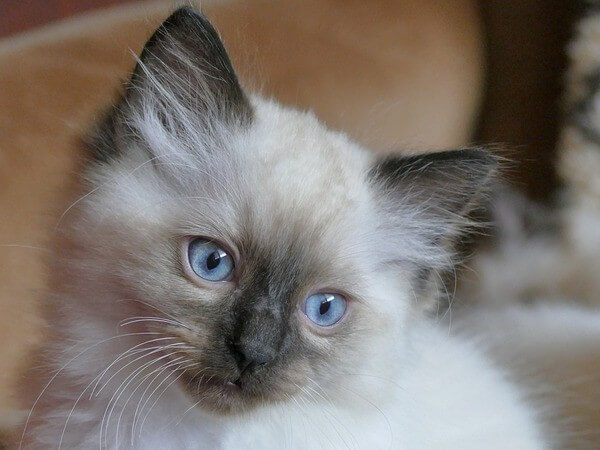
Ragdolls are one of the larger domesticated cats available with the Blue Rag Doll being the second most popular color after the Seal Ragdoll. Below is a brief description of what to expect from Ragdoll Blues.
| Size | Large |
| Weight | 15 – 20 pounds |
| Height | 9 – 11 inches |
| Coat Colors | White, Gray |
| Child Friendliness | High |
| Feline Friendliness | High |
| Training Difficulty | Moderate |
| Grooming Upkeep | Moderate – High |
| Exercise Needs | Low – Moderate |
| Health | Moderate |
| Lifespan | 12 – 16 years |
| Kitten Cost | $1,400 upwards |
What is a Blue Ragdoll Cat?
A Blue Ragdoll Cat is a Ragdoll with gray or grayish-brown points in the ears, face, paws, and tail with a body coat color that ranges from white to light gray.
Are Blue Ragdolls rare?
No, Blue Ragdoll Cats are not rare although they are less common than the Seal Point Ragdolls.
Is Blue a recognized Ragdoll Cat color?
Yes, Blue Ragdolls are one of the accepted colors of the Ragdoll together with seal, chocolate, red, cream, and lilac.
WANT MORE INFORMATION? Check out Red Ragdoll Cat (Complete Guide)
Lilac vs Blue Ragdoll
The main difference between Lilac Ragdoll and Blue Ragdoll is that Lilac Ragdoll has a milkish-white body coat with very light pinkish-gray colorpoints while Blue Ragdoll has a light bluish-gray body coat and cold gray colorpoints.
Lilac is one of the rarest colors for Ragdolls with the seal being the most popular and blue following next.
DON’T MISS: Lilac Ragdoll (Complete Guide)
Blue Ragdoll physical appearance
The Blue Ragdoll shares the same physical appearance as all Ragdolls with long, muscular bodies. They have wide chests, short necks, and bushy tails.
Blue Ragdolls have large and round eyes with ears that are widely spaced.
The single coat is long and plush with considerable thickness around the neck and tail.
What color are Blue Ragdolls’ eyes?
The eye color of the Blue Ragdoll ranges from icy to dark blue just like all traditional Ragdolls.
Do all Ragdoll Cats have Blue eyes?
Purebred Ragdolls all have blue eyes which makes it one of their defining attributes. However, some Ragdoll varieties, like the Mink Ragdoll, Sepia, or Solid Ragdoll (which are not recognized by The International Cat Association (TICA), can have green, blue-green, or gold eye colors.
Blue Ragdoll Cat colors and patterns
The body coat color of the Blue Ragdoll ranges from white to light gray with blue coloring in the points – ears, face mask, paws, legs, and tail. The blue coloring in the points is actually gray to grayish-brown and not really blue, which some people might mistakenly refer to as a gray Ragdoll.
The points in a Blue Ragdoll can come in three (3) patterns, namely, colorpoint, mitted, or bicolor. It can be further subdivided if it is shaded, like the tortie, tabby, or lynx markings.
CHECK OUT: Tortie Ragdoll Cat (Complete Guide)
Blue bicolor Ragdoll
Blue bicolour Ragdoll Cat have gray to grayish brown points in the ears, side of the face, and tail. Blue bicolour Ragdoll Cats have a white inverted ‘V’ mark on the middle of their face.
Some Ragdoll Blue bicolor also has a ‘saddle’ marking on its back that is light grayish in color. Also, the hairs in the chin, chest, tummy, and paws of a Ragdoll Cat Blue bicolor are white.
The paws and nose of a Blue Bicolor Ragdoll Cat are pink in color. Blue bicolor Ragdolls also have the characteristic blue eyes of the Ragdoll.
Blue Bicolor Ragdoll kitten are born completely white with color starting to appear in 2 weeks and gradually darkening as they mature.
Blue Grey Ragdoll Cat
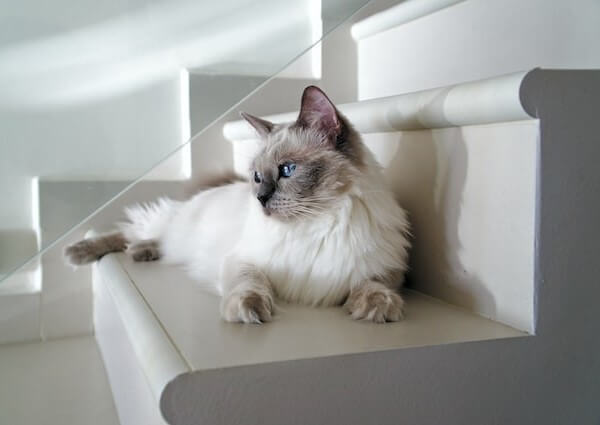
Grey Blue Ragdoll Cat have dark gray points in the face, ears, paws, and tail. Their body coat is grayish white that looks almost white making them appear like a Blue and white Ragdoll Cat.
Blue Lynx Ragdoll
Blue Lynx Ragdoll Cat has gray tabby points on the face with distinguishable ‘M’ pencil markings on the forehead. Blue lynx Ragdoll is also known as Blue Tabby Ragdoll Cat and it has light gray body color with the chest and back being typically white.
The points in the ears of a Blue Lynx colorpoint Ragdoll Cat are deep blue-gray that has a pale thumbprint mark at the center.
Additionally, the points in the legs, paws, and tail of a Blue Lynx point Ragdoll Cat can also exhibit dark and light tabby markings. Ragdoll Cat Blue Lynx point has blue eyes, and the nose is in gray slate with some exhibiting pink edges.
As with all purebred Ragdolls, the Blue Lynx Ragdoll kitten is born white.
Blue lynx bicolor Ragdoll
Blue Bicolor Lynx Ragdoll has a white inverted ‘V’ marking on the center of the face with tabby markings on the forehead. Blue Lynx Bicolor Ragdoll Cat will have dark gray points on the side of the face, ears and tail, but the paws are in white. There can also be light gray markings on the body.
Blue lynx mitted Ragdoll
Blue Lynx Mitted Ragdoll Cat has dark gray points on the ears and tail with tabby markings on the face and an ‘M’ tabby mark on the forehead. Their paws are white with the legs having a light gray color.
Blue mink lynx Ragdoll
Blue Lynx Mink Ragdoll has a darker gray body coat compared to the traditional Blue Ragdoll. They have dark gray tabby points on the face, including the ‘M’ marking, as well as, dark gray points in the ears, paws, and tail.
RECOMMENDED: Ragdoll Tabby Mix (Complete Guide)
Blue point Ragdoll
Blue point Ragdoll has gray points at the extremities – ears, nose, paws, and tail. The body coat color is light bluish gray that has a cool tone.
Blue mink Ragdoll
Blue Mink Ragdoll Cat has a gray body coat that is thicker and softer than traditional Ragdolls. Points in the face, ears, paws, and tail are dark gray. They are not born white but with a light gray color.
Blue mink bicolor Ragdoll
A variation of the Blue mink Ragdoll, the Blue Bicolor Mink Ragdoll has a white inverted ‘V’ shape on the center of the face. Points in the ears and tail are dark gray while the chin and paws are white. Body coat color is gray including the legs.
Ragdoll Blue mitted
Ragdoll Blue mitted has gray points on the ears, face, and tail with the paws being white in color. Blue Mitted Ragdoll kitten is born white but will develop body coat color, including the legs, that is light gray in color.
Blue mink mitted Ragdoll
Blue mink mitted Ragdoll presents with a gray body coat with dark gray points on the face, ears, and tail. Paws are colored white with the legs having a gray color emphasizing the mitten appearance.
Blue seal point Ragdoll
Blue Seal point Ragdoll Cat has a dark brown points in the ears, face, paws, and tail. Blue Seal Ragdoll Cat has a body coat that is light gray in color.
Seal vs Blue Ragdoll
The main difference between Seal Ragdoll and Blue Ragdoll is that Seal Ragdoll has a white to light brown body color with dark brown points while Blue Ragdoll has a cool white to light gray body coat with gray points at the extremities.
DON’T MISS: Seal Lynx Ragdoll (Complete Guide)
Solid Blue Ragdoll
Solid Blue Ragdoll Cat has a light gray body coat since birth and will continue to deepen as he matures. Points in the extremities are dark gray in color.
Blue tortie Ragdoll
Blue Tortie Ragdoll Cat has gray and cream mottled points on the face, ears, and tail. They are mainly females with a body coat that is a soft gray tone.
Blue tortie bicolor Ragdoll
Blue Tortie Bicolor Ragdoll presents with a white inverted ‘V’ pattern on the middle of the face and mottled patches of gray and cream on the side of the face, as well as, the ears. Paws, chest, and underbelly is white.
Blue sepia Ragdoll
Blue Sepia Ragdoll Cat has a reddish-brown body coat since birth. Points in the extremities are dark gray. Their eye color can be green or gold.
Blue cream Ragdoll Cat
Blue Cream Point Ragdoll Cat presents with a cool platinum gray body coat with points in the extremities as gray mixed with some cream or pale white.
Blue cream tortie Ragdoll Cat
Blue cream tortie Ragdoll Cat is almost the same as the Blue Cream Ragdoll except that the mottling in the points is mixed with light orange.
RELATED: Orange Ragdoll Cat (Complete Guide)
Blue calico Ragdoll Cat
Blue Calico Ragdoll Cat has three colors in its body coat – white, light gray, and light orange. Points in the ear, face, tail, and legs will have mottled patches of light gray, orange, and white.
ALSO READ: Calico Ragdoll (Complete Guide)
Ragdoll Blue size, height, and weight
Ragdolls are large domesticated cats that can weigh between 15 and 20 pounds with the males being slightly larger. Ragdolls typically reach their full size by age 4.
| Height | Weight | Length | |
| Male | 9-11 inches | 15-20 pounds | 17-21 inches |
| Female | 7-9 inches | 18-19 pounds | 17-19 inches |
Blue Rag Doll Cat personality and temperament
A Blue Rag Doll cat has a very loving and gentle personality. He is never aggressive or difficult to live with. He shows his affection in more ways than one such as wanting to be beside his owner all the time.
And, if a Blue Rag Doll headbutts his owners, it means he wants to pass on his scent as a sign of acceptance and affection.
Blue Ragdoll Cat training
No one should ever doubt the intelligence of a Blue Ragdoll. He is smart and can be taught some cat tricks that can delight people of all ages.
Just be sure to gift a Blue Ragdoll cat with positive reinforcements, in the form of cat treats and a gentle pat on the back.
You can also use the timeout technique wherein you limit the training sessions to just a few minutes, about three times a day.
Blue Ragdoll Cat exercise requirement
Blue Ragdoll cat owners are delighted that this cat breed is not as active compared with other cats. A light form of indoor exercise such as chasing a laser light or fetch games is a great form of physical activity for a laid-back cat like a Blue Ragdoll.
Blue Ragdoll Cat grooming and cleaning
If a Blue Ragdoll cat is not too demanding in his exercise requirements, such as not the case when it comes to grooming.
Remember that a Ragdoll is a long-haired cat breed, hence, brushing the fur as often as you can is necessary. If not, mats will form which can be hard to manage. The only solution to prevent the formation of mats is to brush the fur with either a de-shedding brush or a slicker brush.
Bath time can be done once a month using a gentle cat shampoo. It’s also a good idea to use a detangler or conditioner after shampooing your Blue Ragdoll.
Next, dental hygiene should also be part of keeping your Blue Ragdoll clean, but don’t share your toothpaste with him, that is just too strong for him. Rather, an enzymatic cat toothpaste is the best choice for his oral care.
| Grooming Needs | Grooming Frequency |
| Hair Brushing | 3 – 4x weekly. |
| Nail Trimming | As needed. |
| Teeth Brushing | 2 -3x weekly. |
| Bathing | Once a month. |
| Eye Care | Check weekly. |
| Ear Care | Check weekly. |
Do Blue Ragdolls shed a lot?
Blue Ragdolls do shed, but it is moderate compared to other cat breeds. They typically shed more during the spring and fall.
To control shedding during peak shedding seasons, brush your cat regularly, ideally once or twice a week, to remove loose hairs.
Regular home cleaning, especially vacuuming, can also keep fur and dander from accumulating. During heavy shedding seasons, increasing the frequency of these activities can help maintain a fur-free home.
Vacuuming is a crucial part of maintaining a clean home, especially for cat owners dealing with pet hair. Investing in a vacuum cleaner with a HEPA filter can be particularly beneficial.
How so?
Well, a HEPA filter works by forcing air through a fine mesh that traps harmful particles such as pet dander, dust mites, and tobacco smoke. These filters can trap 99.97% of particles that are 0.3 microns in size, which includes most allergens.
Additionally, using a vacuum cleaner with HEPA filter can help with the following:
- Allergen reduction: by trapping pet dander, which is a common cause of allergies. This can help reduce allergic reactions in those sensitive to these allergens, providing a healthier home environment.
- Improved air quality: By trapping dust, pollen, and other small particles, HEPA filters can significantly improve the overall air quality in your home.
- Efficient Cleaning: Vacuums with HEPA filters often provide stronger suction and more efficient cleaning, making them better at picking up pet hair from various surfaces.
- Odor Control: Some HEPA filters come with activated charcoal layers that can help control pet odors.
RELATED: Do Ragdoll Cats Shed? 7 Ways To Shed Less!
Are Blue Ragdolls hypoallergenic?
No, Blue Ragdolls are not considered hypoallergenic. They produce normal levels of the allergenic protein called Fel d 1. The Fel d 1 is found in cat dander and saliva, and can trigger allergic reactions in sensitive individuals.
If you have feline allergies, here are several steps you can take to manage your symptoms while sharing your home with your precious kitties:
- Create an Allergy-Free Zone: Designate a room or area in your house, ideally the bedroom, where your cat is not allowed. This can provide a safe space for anyone with allergies to retreat to when symptoms flare up.
- Frequent Cleaning: Regularly clean your home to remove allergens. Use a vacuum cleaner with a HEPA filter (as discussed above) to effectively capture small allergen particles. Regularly wash bedding, curtains, and any other fabrics that can hold allergens.
- Air Purifier: Invest in a good quality air purifier with a HEPA filter. This can help remove allergens from the air and reduce the overall allergen level in the home.
- Grooming: Regular grooming can help reduce the amount of dander and hair your cat sheds. Brush your cat frequently, and consider using pet wipes to help remove allergens from their coat. Some people find it helpful to have a non-allergic family member do the grooming.
- Wash Hands: After petting your cat, always wash your hands. Try to avoid touching your face, particularly your eyes and nose, after contact with your cat.
- Consult a Doctor: If symptoms persist, consult a doctor or allergist. They can provide advice and treatment options, which may include allergy medications or immunotherapy.
RECOMMENDED: Are Ragdoll Cats Hypoallergenic?
Blue Ragdoll Cat food and diet
The best cat food for a Blue Ragdoll cat is canned or wet cat food because of its higher water content.
An amount of ½ cup to ¾ cup, divided into 2 or 3 portions is what we recommend.
Keep in mind that a Blue Ragdoll cat is not an active breed, hence, he tends to gain weight. That said, yes, you can give him nice treats but in small quantities only.
Blue Ragdoll Cat health issues
Although Blue Ragdolls are generally healthy cats and are known for their robust health, they have the potential to develop certain health issues based on their genetic makeup.
This is why regular veterinary check-ups, a healthy diet, plenty of exercise, and a stimulating environment are all crucial in maintaining your cat’s overall health and well-being.
During your Ragdoll’s veterinary check-up, you can discuss with the vet any breed-specific health issues you should be aware of.
If you can’t afford this option, don’t fret! A great alternative would be to find out through a cat DNA and health detection test, which you can use in the comfort of your own home.
A cat DNA and health detection test can provide valuable insights into your Blue Ragdoll’s health profile, including breed-specific predispositions. Early detection can lead to more successful treatment, while preventive care and personalized attention can significantly improve their wellbeing.
Overall, these tests are a proactive step in safeguarding your cat’s health.
A Blue Ragdoll cat is prone to hereditary health issues including these three (3) below:
1. Polycystic Kidney Disease
The affected kittens are born with small cysts in the kidneys that grow bigger as they age. The common sign is increased urination.
2. Obesity
Ragdolls are lazy cats, so instead of climbing scratch posts, they would rather lie down next to or beside their humans. Thus, they easily gain weight which can lead to diabetes and heart problems.
READ ALSO: Do Ragdoll Cats Scratch Furniture?
3. Urinary Tract Infections
Quite common among Ragdolls, especially the females, the signs are painful urination and blood in the urine.
Blue Ragdoll Cat lifespan
Given the right care, a Blue Ragdoll has an average life expectancy of 12 to 16 years.
Blue Ragdoll Cat breeders
Never settle for anything less, thus, buying from a responsible Blue Ragdoll breeder is the way to go. In this way, you are assured that your kitten will be in good health. And, in case something happens, responsible breeders provide a kitten warranty wherein they shoulder the medical expenses within an agreed time period.
Cat breeders that are reputable and ethical will always perform a genetic testing on the parent cats before they breed. Again, this is to ensure that the kittens produced will be healthy with no genetic defects.
Also, most often than not, responsible breeders are members of the organization such as The International Cat Association or TICA.
Blue Ragdoll kitten
Blue Ragdoll kittens are adorable pets to have but you also have to factor in the expenses that come with owning a Ragdoll Blue kitten.
Be sure to prepare and buy the following for your kittens before you bring them home.
- Food and water bowls.
- Cat bed.
- Collar.
- Leash with a name tag.
Blue Ragdoll Cat price
The average cost of buying a Blue Ragdoll from a reputable breeder is $1,200.
Places to find Blue Ragdoll kittens for sale
We have listed two (2) responsible breeders from whom you can get your Blue Ragdoll kitten. Rest assured that we have reviewed and found them to produce healthy kittens.
The first breeder we recommend is the Blue Gem Ragdolls (ragdoll-breeder.com) which is a TICA (The International Cat Association) and CFA (Cat Fanciers’ Association) registered cattery. They’re one of Georgia’s premier Ragdoll cat breeder and offer both kittens and cats for sale in Florida, Georgia, and South Carolina.
Blue gem Ragdoll Cats have been breeding Ragdolls for more than 30 years and are devoted to producing Ragdoll kittens for pet, therapy, and shows.
Check out Cherish Lewis (cherishlewis.co.uk) in the UK, the average price of the kittens is $1,700. The breeder is a registered member of TICA and they have 24 hours CCTV inside and outside their premises as well as security guards to ensure that their Ragdoll kittens live in a safe environment.
Finding a healthy Blue Ragdoll Cats for sale
In this section, we’ll help you locate breeders with adult Blue Ragdoll Cat for sale.
You can ask the breeder at Badgerrags Ragdoll Kittens (badgerrags.com) if they have retired Ragdolls that need to be rehomed.
Ragmeister Ragdolls (ragdoll.org) in California occasionally have retired Ragdoll cats aged 2 to 5 years and older that are sold for $250.
Blue Ragdoll Mix
Due to the amiable nature of a Ragdoll, some breeders crossbreed them with other cat mixes such as with a Siamese cat.
Blue Siamese Ragdoll Cat
A Blue Siamese Ragdoll cat is a large breed that has long, silky hair and demonstrates a pleasant personality pretty much like his Blue Ragdoll parent.
Blue Ragdoll: Pros and Cons
To better understand, here are the qualities that you can expect from a Blue Ragdoll cat.
| Pros | Cons |
| Gentle with children. | Has separation anxiety problem. |
| Gets along well with other pets. | Sheds moderately. |
| Enjoys being cuddled. | Not hypoallergenic. |
| Does not hiss or scratch. | Requires frequent brushing. |
| Elegant looking cat. | Tends to gain weight easily. |
| Laid-back personality. | Prone to gene-related diseases. |
Is the Blue Ragdoll Cat right for me?
A beautiful, gentle, and amiable cat breed, the Blue Ragdoll Cat has no problem living peacefully with other pets and people of all ages. The only issue is that this breed is not hypoallergenic, so if you are sensitive to the protein in his saliva, you will encounter issues concerning your health.
Related Questions
A Blue Ragdoll kitten will usually cost around $1,200 from a reputable and ethical breeder. In some cases, you can expect to pay $1,400 or more depending on where the breeder is located, the number of kittens in the litter, the various Blue Ragdoll Cat colors, and how many years the breeders have been in business.
Yes, you can get a solid Blue Ragdoll. A solid Blue Ragdoll has a light gray coat color that continues to darken as he gets older.
DISCLAIMER: THIS WEBSITE DOES NOT PROVIDE MEDICAL ADVICE
The information, including but not limited to, text, graphics, images and other material contained on this website are for informational purposes only. No material on this site is intended to be a substitute for professional veterinary advice, diagnosis, or treatment. Always seek the advice of your veterinarian or other qualified health care provider with any questions you may have regarding a medical condition.
Resources:
https://www.ncbi.nlm.nih.gov/pmc/articles/PMC6709657/
https://vcahospitals.com/know-your-pet/kidney-disease-polycystic-kidney-disease-in-cats
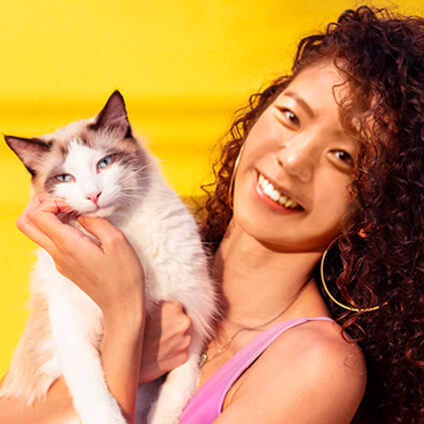
With over five years of specialized experience as an animal writer, my expertise lies in cat nutrition, health, behavior, grooming, and training. I am dedicated to delivering helpful and informative content that caters to the well-being of our feline friends. My primary goal is to empower pet owners with knowledge and ensure our feline companions thrive in health and happiness. In my free time, I love volunteering at local cat rescue centers.
